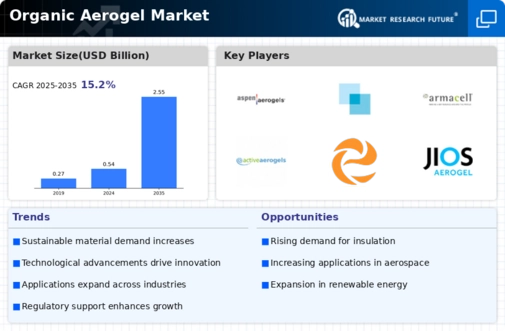Market Analysis
In-depth Analysis of Organic Aerogel Market Industry Landscape
The market dynamics of the organic aerogel market are influenced by various factors that drive its supply, demand, and pricing. Organic aerogels, lightweight and highly porous materials derived from organic polymers, find applications in a wide range of industries, including aerospace, construction, electronics, and oil and gas. One of the primary drivers shaping the market dynamics is the increasing demand for organic aerogels in the aerospace and automotive sectors. Organic aerogels are utilized in aerospace applications for thermal insulation, lightweight structural components, and sound absorption. In the automotive industry, they are used for lightweighting purposes to improve fuel efficiency and reduce emissions. As the aerospace and automotive industries continue to focus on efficiency, sustainability, and performance, the demand for organic aerogels is expected to grow, driving market expansion. Supply-side factors play a significant role in the market dynamics of organic aerogels. The production of organic aerogels involves complex synthesis processes, including sol-gel polymerization and supercritical drying techniques, which require specialized equipment and expertise. Therefore, the availability of raw materials, such as organic polymers and solvents, as well as advancements in manufacturing technologies, significantly impact production capacity and supply levels. Additionally, the presence of key manufacturers with expertise in aerogel production influences market dynamics, with expansions or disruptions affecting supply volumes and pricing. Global trade patterns and regulatory frameworks contribute to the complexity of organic aerogel market dynamics. Many countries rely on imports to meet their demand for organic aerogels, leading to fluctuations in prices and supply chains. Trade policies, tariffs, and regulations regarding the import and export of chemicals and advanced materials influence market dynamics by affecting supply levels and pricing structures. Moreover, regulatory measures related to product safety, environmental standards, and energy efficiency impact the production, distribution, and usage of organic aerogels, influencing market dynamics and pricing strategies. The pricing dynamics of organic aerogels are influenced by various factors, including raw material costs, production costs, and market competition. Fluctuations in the prices of organic polymers, solvents, and other raw materials directly impact production costs, thereby influencing pricing dynamics. Energy prices and transportation costs also contribute to production expenses, affecting pricing strategies adopted by manufacturers. Market competition among suppliers and manufacturers further influences pricing dynamics, with companies adjusting their pricing strategies to gain market share or maintain profitability in a competitive landscape. Demand-side factors, such as technological advancements and trends in end-user industries, shape the market dynamics of organic aerogels. In industries like electronics and energy storage, the demand for organic aerogels is driven by factors such as miniaturization of devices, improved performance requirements, and advancements in battery and capacitor technology. Moreover, shifts in consumer preferences towards eco-friendly and sustainable materials drive demand for organic aerogel-based solutions, impacting market dynamics and pricing strategies. Market dynamics in the organic aerogel sector are also influenced by cyclical trends and seasonal variations. Certain industries, such as construction and oil and gas, experience fluctuations in demand for organic aerogels based on factors such as construction activity levels, oil prices, and seasonal variations in energy demand. Moreover, economic factors, global crises, and shifts in geopolitical dynamics can disrupt supply chains, affect consumer spending, and impact the overall demand for organic aerogels, leading to fluctuations in market dynamics and pricing structures.











Leave a Comment